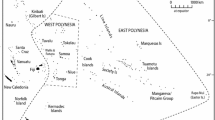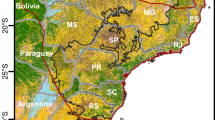Abstract
Social organization of the Asian elephant (Elephas maximus) is not well understood in the absence of long-term studies of identified individuals. Adult Asian elephant females and their young offspring of both sexes form matriarchal groups, with pubertal males dispersing from natal groups, but whether these social groups represent families and whether males show locational or social dispersal were unknown. Using nuclear microsatellite loci amplified from dung-extracted DNA of free-ranging elephants in a large southern Indian population, we demonstrate that female-led herds comprise closely related individuals that are indeed families, and that males exhibit non-random locational dispersal.

Similar content being viewed by others
References
Amos B, Schlötterer C, Tautz D (1993) Social structure of pilot whales revealed by analytical DNA profiling. Science 260:670–672
AERCC (1998) The Asian elephant in southern India: a GIS database for conservation of Project Elephant Reserves. Asian Elephant Research and Conservation Centre, Bangalore
Banks PB (2001) Predation-sensitive grouping and habitat use by eastern grey kangaroos: a field experiment. Anim Behav 61:1013–1021
Baskaran N (1998) Ranging and resource utilization by Asian elephant (Elephas maximus Linnaeus) in Nilgiri Biosphere Reserve, South India. PhD Thesis, Bharathidasan University, Tamilnadu India
Baskaran N, Balasubramanian S, Swaminathan S, Desai AA (1995) Home range of elephants in the Nilgiri Biosphere Reserve, south India. In: Daniel JC, Datye HS (eds) A week with elephants. Bombay Natural History Society and Oxford University Press, Bombay, pp 296–313
Blundell GM, Ben-David M, Groves P, Bowyer RT, Geffen E (2004) Kinship and sociality in coastal river otters: are they related? Behav Ecol 15:705–714
Brockelman WY, Reichard U, Treesucon U, Raemakers JJ (1998) Dispersal, pair formation and social structure in gibbons (Hylobates lar). Behav Ecol Sociobiol 42:329–339
Cheney DL (1983) Promixate and ultimate factors relationed to the distribution of male migration. In: Hinde R (ed) Primate social relationships. Blackwell, Boston, pp 241–249
Cheney DL, Seyfarth RM (1983) Nonrandom dispersal in free-ranging vervet monkeys: social and genetic consequences. Am Nat 122:392–412
Croze H (1972) A modified photogrammetric technique for assessing age-structures of elephant populations and its use in Kidepo National Park. East Afr Wildl J 10:91–115
Desai AA, Johnsingh AJT (1995) Social organization and reproductive strategy of the male Asian elephant (Elephas maximus). Abstract in: Daniel JC, Datye HS (eds) A week with elephants. Bombay Natural History Society and Oxford University Press, Bombay, pp 532
Douglas-Hamilton I (1972) On the ecology and behaviour of the African elephant: the elephants of Lake Manyara. DPhil thesis, University of Oxford
Fernando P, Lande R (2000) Molecular genetic and behavioural analysis of social organization in the Asian elephant (Elephas maximus). Behav Ecol Sociobiol 48:84–91
Fernando P, Vidya TNC, Melnick DJ (2001) Isolation and characterization of tri- and tetranucleotide microsatellite loci in the Asian elephant, Elephas maximus. Mol Ecol 1:232–234
Fernando P, Vidya TNC, Rajapakse C, Dangolla A, Melnick DJ (2003) Reliable non-invasive genotyping: fantasy or reality? J Hered 94:115–123
Fleischer R, Perry E, Muralidharan K, Stevens E, Wemmer C (2001) Phylogeography of the Asian elephant (Elephas maximus) based on mitochondrial DNA. Evolution 55:1882–1892
Gadgil M, Nair PV (1984) Observations on the social behaviour of free-ranging groups of tame Asiatic elephant (Elephas maximus Linn.). Proc Indian Acad Sci (Anim Sci) 94:575–586
Goodnight KF, Queller DQ (1999) Relatedness version 5.0. Available from http://gsoft.smu.edu/Gsoft.html
Greenwood PJ (1980) Mating systems, philopatry and dispersal in birds and mammals. Anim Behav 28:1140–1162
Hamilton WD (1964) The genetical evolution of social behaviour. J Theor Biol 7:1–52
Isbell LA, Van Vuren D (1996) Differential costs of locational and social dispersal and their consequence for female group-living primates. Behaviour 133:1–36
Jarne P, Lagoda PJL (1996) Microsatellites, from molecules to populations and back. Trends Ecol Evol 11:424–429
Lee P (1991) Social Life. In: Eltringham SK (ed) The illustrated encyclopedia of elephants. Salamander, London, pp 48–63
Lee PC, Moss CJ (1999) The social context for learning and behavioural development among wild African elephants. In: Box HO, Gibson KR (eds) Mammalian social learning: comparative and ecological perspectives. Cambridge University Press, Cambridge, pp 102–125
McKay GM (1973) The ecology and behavior of the Asiatic elephant in southeastern Ceylon. Smithson Contrib Zool 125:1–113
Meikle DB, Vessey SH (1981) Nepotism among rhesus monkey brothers. Nature 294:160–161
Morin PA, Moore JJ, Chakraborty R, Jin L, Goodall J, Woodruff DS (1994) Kin selection, social structure, gene flow, and the evolution of chimpanzees. Science 265:1193–1201
Moss CJ (1988) Elephant memories: thirteen years in the life of an elephant family. William Morrow, New York
Moss, CJ (2001) The demography of an African elephant population (Loxodonta africana) population in Amboseli, Kenya. J Zool Lond 255:145–156
Moss CJ, Poole JH (1983) Relationships and social structure of African elephants. In: Hinde R (ed) Primate social relationships. Blackwell, Boston, pp 315–325
Nyakaana S, Arctander P (1998) Isolation and characterization of microsatellite loci in the African elephant, Loxodonta africana. Mol Ecol 7:1436–1437
PE Applied Biosystems (1998) ABI GeneScan Analysis Software v3.1. PE Applied Biosystems, Foster City
Poole JH (1996) Coming of age with elephants. Hyperion Press, New York
Poole JH, Moss CJ (1981) Musth in the African elephant, Loxodonta africana. Nature 292:830–831
Queller DC, Goodnight KF (1989) Estimating relatedness using genetic markers. Evolution 43:258–275
Richard KR, Dillon MC, Whitehead H, Wright JM (1996) Patterns of kinship in groups of free-living sperm whales (Physeter macrocephalus) revealed by multiple molecular genetic analyses. Proc Natl Acad Sci USA 93:8792–8795
Shrader AM, Owen-Smith N (2002) The role of companionship in the dispersal of white rhinoceroses (Ceratotherium simum). Behav Ecol Sociobiol 52:255–261
Sukumar R (1989) The Asian elephant: ecology and management. Cambridge University Press, Cambridge
Sukumar R (1994) Elephant days and nights: ten years with the Indian elephant. Oxford University Press, New Delhi
Sukumar R (2003) The living elephants: evolutionary ecology, behavior, and conservation. Oxford University Press, New York
Vidya TNC, Fernando P, Melnick DJ, Sukumar R (2005) Population differentiation within and among Asian elephant (Elephas maximus) populations in southern India. Heredity 94:71–80
Acknowledgements
Fieldwork was funded by the Ministry of Environment and Forests, Government of India and samples were collected with research permissions from the state forest departments of Tamil Nadu and Karnataka. The molecular work was supported by the United States Fish and Wildlife Service–Asian Elephant Conservation Fund (USFWS-AECF) and the Columbia University Laboratory for Genetic Investigation and Conservation (LOGIC). We thank Prof. Don Melnick and Dr. Prithiviraj Fernando of Columbia University for their support and help. Dr. Uma Ramakrishnan collected the set of mother-offspring samples we used to test for Mendelian inheritance of microsatellite loci. Mr. K. Krishna, Mr. R. Mohan, and several forest department trackers provided field assistance. We thank two anonymous reviewers whose comments helped us in improving this manuscript. This work constitutes part of the doctoral thesis of T.N.C.V.
Author information
Authors and Affiliations
Corresponding author
About this article
Cite this article
Vidya, T.N.C., Sukumar, R. Social organization of the Asian elephant (Elephas maximus) in southern India inferred from microsatellite DNA. J Ethol 23, 205–210 (2005). https://doi.org/10.1007/s10164-005-0144-8
Received:
Accepted:
Published:
Issue Date:
DOI: https://doi.org/10.1007/s10164-005-0144-8




